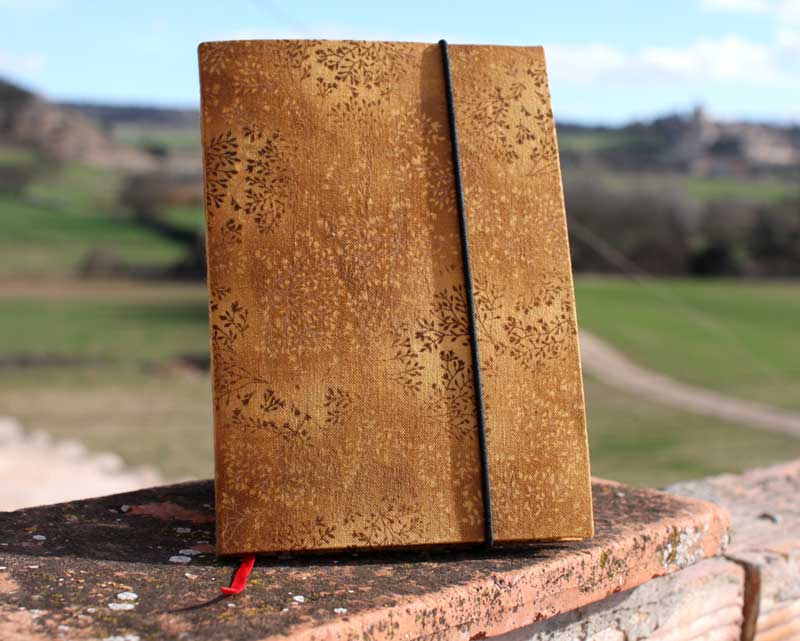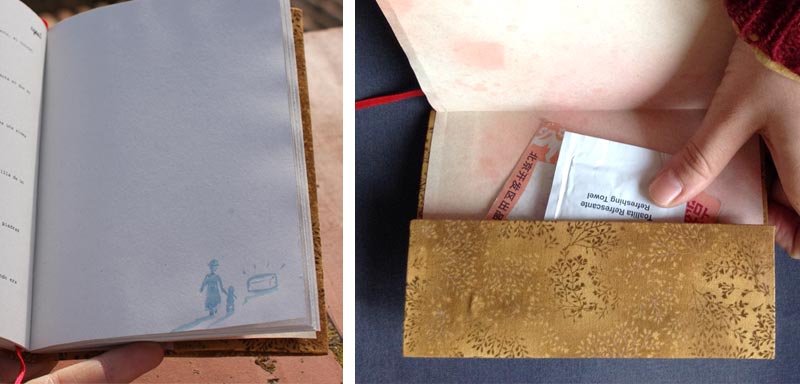11 Jan 2016
There is a charm, a magic about agendas that I can’t really explain. In my schooldays, I remember how special the day was when I went to the book store to get my textbooks and also choose an agenda for the next school year. I would spend so much time looking at all the available ones carefully, the cover, the size, the design… It was a difficult choice but very enjoyable, and I loved using them month after month.

With time, though, as my life follows no schedule and I have little to organize, my agendas would growingly end up empty, unused, sad. So, even though I still browse through them when they appear in the stores by the end of the year, I don’t let myself buy any, because it just makes me sad to keep them blank.
But I discovered something: I can revisit some of that magic in the action of bringing an agenda to life.

These pockets are an envelope divided in two by the binding.
So I ended last year and started 2016 immersed in this process. I designed how the week would look, printed each page in my home printer, manually feeding the pages one by one to print the back sides. I found a nice fabric in a small shop for the cover, and with some paper that I decorated as a craft in my childhood -yellowed with the years- as endpapers, some fun details like back pockets, a bookmark, made with a ribbon I found on the street, and an elastic closure, I am very happy with the overall result, and as always I hope it is durable enough for intensive use.

One of the illustrations… Anybody recognize the scene? And the back pocket.
And there is something else: as I was working on the page design, I was testing the use of typographical symbols as a separation line between the weekdays… But I had a better idea: couldn’t it be actual text, in small print, forming a visual line, as a separation, yet at the same time adding a bit of extra content? From here on it evolved into the idea of using the beginnings of books and texts, some classics, some books I really like, some poems, that would in fact become a riddle for each week: what book is it? Would it be easy to guess? And if not, it would become a book recommendation. On the opposite page I included illustrations related to each of the texts.

This one is in several languages: catalan, spanish, english, french and italian. I am playing with the idea, though, to make a version in a more accessible mix of languages or in just one, and see if anybody would like to have one.
I must say I had a lot of fun doing it, I hope it’s also fun to use!
filed in
Books · tagged agenda, paperback, sitched and glued, upcycle
24 Feb 2014

This year, between moving and travelling, we haven’t made any big edition of agendas like last year, and just a couple of monthly planners for those who were happier with the ones from 2013.
For a present, though, we made this unique agenda, in which each page has been individually hand painted and which also has an embroidered cover.

View of the cover and the back
We used recycled paper and photocopied it using an old machine, the cover is made with used cardstock, threads and a piece of a broken cardigan. When we put a few not so interesting things together, it’s amazing what kind of results we can get. Don’t you think?

1. Sample inside page 2. Detail of the elastic attachment 3. Inside pocket 4. View from top
filed in
Books · tagged agenda, embroidery, upcycling
1 Apr 2013

Yes, Edicions Cotton Flower is pretty much alive, just maybe hibernating after the agenda hangover. This is our last creation: a photo album (blank) with a 3-D fabric pinwheel on the cover! I’m especially happy with the colour combination. And see, I can go beyond blue and brown!
I sewed the cover with different fabric scraps, the pages are Canson 180 g/m2 cardstock (from the shop) and the album is held together with black linen thread using a binding called coptic, you can recognise it because the spine remains uncovered and the stitches form chains along it.
This kind of binding is very appropriate for albums and scrapbooks because they can be filled with pictures, papers, and such, without the book bulging too much like with most bindings. This is the first time we’ve try this bookbinding technique, and even though it is not perfect, we are quite happy with it and will attempt it again!

The pinwheel on the cover is a quilting block I adapted (the original didn’t have as many colors, but it had a much better finish!).
filed in
Books · tagged àlbum, copte, coptic, hardcover, stitched
15 Jan 2013

We’ve been a little busy during the year change season trying to get the more than 25 agendas we’d been commissioned to ready! Here’s to hoping they’ll help their now owners organize themselves :)
Above and below these lines there are images of the agenda that The Kruch designed and that he sells online in his Etsy store. It’s been good practice to bind for the first time a considerable series of books with content in them, of which we only had the experience of a single copy of a novel for its author. The fact that we print such small editions and we have to depend on printers over which we have no control whatsoever makes printing irregularities the norm, something we are not completely pleased about. But, what can you do! The results are nevertheless quite satisfactory and their recipients seem to be happy about them!

We also did a small edition of a 2013 version of the monthly view planner (we only have one page of the portuguese tiles’ calendar left!) and we designed our own weekly view planner, based on the earlier’s design, but in black and white for economy.
In all of the agendas most materials are new: the pages are white paper printed digitally in a copy shop… But the inside of the covers is made with cereal box card or something similar and, of course, the monthly planners’ covers are still made with an old calendar.

filed in
Books · tagged agenda, edició, edition, sitched and glued
19 Dec 2012

This journal is a commission that gave us a lot of creative freedom, and throughout the whole process of paper hunting across Barcelona’s paper bins, envisioning the design, stitching it onto fabric, and turning it all into a pretty little book it remains a clear example of the reasons why we decided to get into bookbinding.

i. stitching the cover ii. the book block is ready iii. preparing the book’s casing iv. we added a button
Pages are two colored (two shades of brown) paper from a recycling bin, held together with linen thread; fabrics are offcuts from different sources, stitched with cotton embroidery floss; endpapers are reused envelopes; bookmark and closing tape are silk ribbon and the vintage wood button comes from Z’s grandma’s button box.



filed in
Books · tagged beauty, embroidery, hardcover, notebook, upcycle
29 Sep 2012

I made this one-month-per-page planner per request. I designed, printed and bound the booklet with a picture of portuguese tiles from an old calendar as a cover. It includes the months from october to september of 2012-13 and each month has a different color, each according to the season. It looks pretty good, but what I really hope is that it gets used and is practical!

If you are interested in having a similar (or different) planner made for yourself, please contact us

filed in
Books · tagged agenda, comissions, pamphlet stitch, planner
27 Sep 2012

The first edition of The Kruch‘s first two little “Cuentos de Ben” storybooks and also some blank notebooks with his drawings as covers are finally ready.
As always they’re hand-bound, trimmed and cornered.
They can already be found in his online store!

filed in
Books · tagged collaboration, notebook, pamphlet stitch, storybook
22 Dec 2011

I made this notebook for my “invisible friend” this year, using one of the book blocks we’d already readied in the summer. We are improving our hardcover technique!
Almost all the materials used for this one were bought: the bookcloth for the spine, the flowery cover fabric, the red headband, the endpapers, the greyboard and of course the tools, glue and thread. The pages were found in a print-shop’s dumpster though, and the bookmark was a present’s wrapping tape.
Between using found or bought materials, the main difference is that most materials we buy are beatiful and made on purpose for bookbinding, which makes the job a lot easier and the results look a lot fancier. For example, the grey bookcloth I used for the spine is reinforced, so it won’t wrinkle and it is a lot easier to work with it than with the regular flower fabric I used for the cover. I think if we bought a lot of nice supplies it would be very easy to make a lot of beautiful notebooks. But I find the input of chance and found materials is what makes each of our books unique!
I am pretty happy with the result, even though I should have put some greyboard inside the spine and in the end it felt a little flimsy. I hope it lasts a long time, though!
Fotos de TAU*MH / Photos by TAU*MH


filed in
Books · tagged cloth cover, hardcover, notebook, sitched and glued
13 Nov 2011

Once again some brown paper meant for the trash was the origin of this notebook’s creation. This brown piece of paper, that I found all wrinkled and in a ball, was very thankful that this new life has now been offered to it and I hope Gina finds something nice to write or draw on it.
The cover includes: a little paper wrapping bag, tea bags, kraft paper (thicker than the one used for the pages).
Inside: brown wrapping paper, sewn with linen thread.
All of this came together thanks to some cardboard (cereal boxes and such) and our best friend, white PVA glue.



filed in
Books · tagged beauty, hardcover, notebook, sitched and glued, upcycle




























